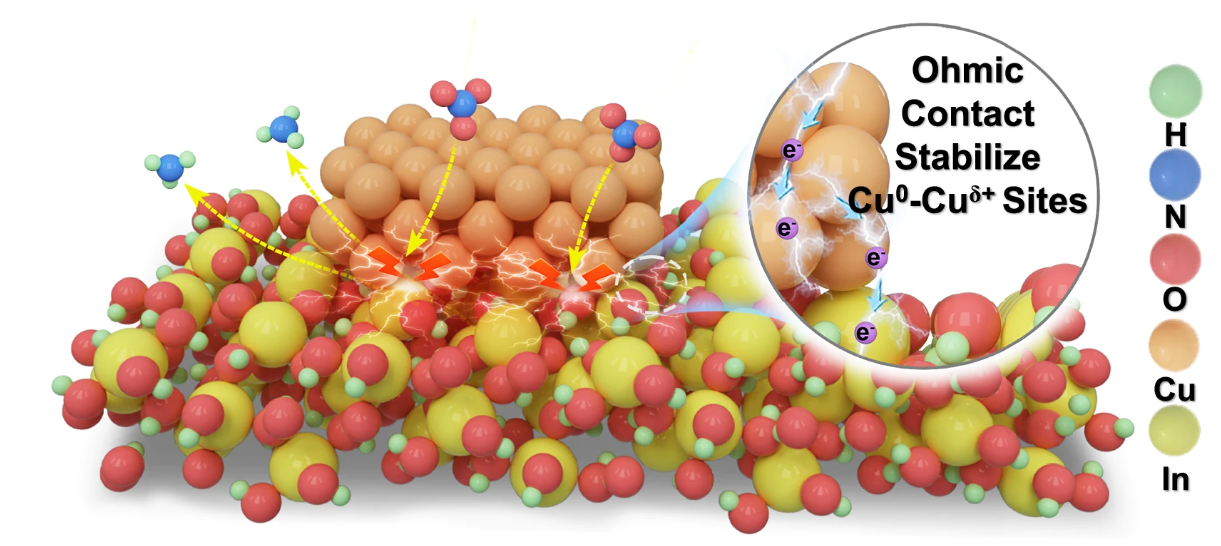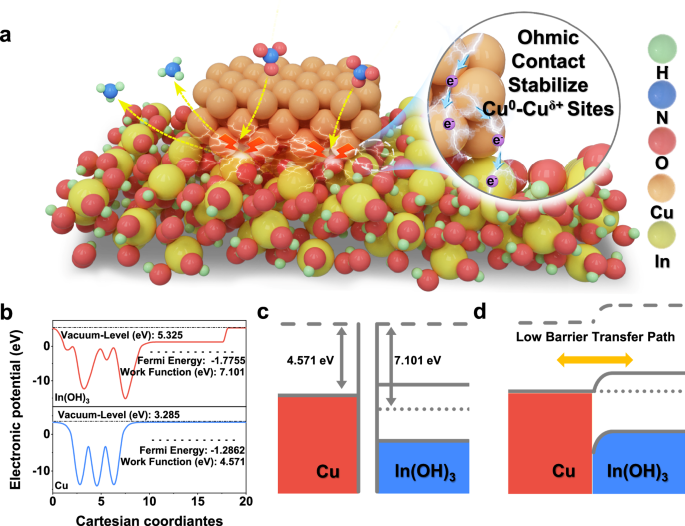An achievable strategy for stabilizing Cu-based catalysts towards industrial-level ammonia electrosynthesis
Published in Sustainability

The motivation
Ammonia (NH3) is both a foundational chemical feedstock and a promising hydrogen carrier. However, conventional Haber-Bosch process remains energy- and carbon-intensive. A more sustainable alternative is electrochemical nitrate reduction (NO3RR), which converts nitrate (often an environmental pollutant) into ammonia under mild conditions. Yet a persistent challenge has been the instability of catalysts: Cu-based catalysts are emerging as the most promising candidates for electrocatalytic reduction of nitrate to ammonia. Nevertheless, they tend to lose Cuδ+ species via self-reduction under strongly reducing potentials, leading to the loss of deactivation and selectivity. Maintaining stable Cu0-Cuδ+ active sites under ampere-level current densities remains a key bottleneck.
We asked ourselves: can we design the catalyst-support interface to stabilize Cuδ+ while maintaining conductivity and catalytic activity?
The origin of the idea
Copper catalysts have long been studied for nitrate electroreduction, due to their favorable adsorption energy and cost-effectiveness. However, their performance is often limited by structural instability under harsh reduction conditions. Traditional approaches rely on electrochemical reduction of oxidized precursors (such as Cu2O or CuO) to generate transient Cu0–Cuδ+ active sites. While these methods can yield high activity initially, they are typically stable only at low current densities and for short durations, failing to maintain performance under industrial-level, ampere-scale operation.
We hypothesized that a fundamental, interface-level strategy might overcome this limitation-one that stabilized the Cu0-Cuδ+ electronically rather than regenerating it through surface redox cycling. This concept led us to develop a metal-semiconductor Ohmic contact interface, where built-in energy alignment drives charge redistribution, inherently stabilizing the mixed-valence Cu0-Cuδ+ configuration during sustained electrolysis.
Our approach: interface energy engineering with Ohmic contact
We designed a Cu@In(OH)3 heterostructure, in which metallic Cu was intimately coupled to the n-type semiconductor support (indium hydroxide, In(OH)3). Because of the difference in work functions, electrons spontaneously migrate from Cu into In(OH)3, forming a low-barrier Ohmic contact. This charge redistribution creates the interfacial polarization that can maintain the mixed-valence Cu0–Cuδ+ configuration, preventing self-reduction while guaranteeing excellent electrical conductivity for catalytic turnover.
Our interface engineering approach thus reconciles two often-conflicting demands in electrocatalysis: durability (preserving Cuδ+ species) and kinetics (ensuring rapid charge and proton transfer).
What we did and key experiments
To validate our concept and uncover the mechanism, we combined advanced operando and in situ techniques with computational modeling:
- In situ XAFS tracked the Cu valence state during electrolysis, confirming that a stable Cuδ+ proportion was maintained in Cu@In(OH)3.
- Operando Raman, SR-FTIR, and DEMS experiments monitored the key reaction intermediates (e.g. *NO2, *NOOH, *NH2) in real time, to determine the reaction pathway of nitrate electroreduction.
- Electrochemical tests demonstrated high ammonia yield, excellent selectivity, and remarkable long-term stability under ampere-scale current densities.
- DFT calculations showed that interfacial polarization modulated adsorption energies and significantly lowerd reaction barriers—most notably, the *NO2 → *NOOH hydrogenation step decreased to ~0.16 eV (versus 0.54 eV on bare Cu).
- We also built a flow-cell electrolyzer coupling NO3RR and OER to demonstrate practical applicability at 1 A·cm−2.
Why it matters
This work establishes a new design paradigm in interface energy engineering for electrocatalysis. By harnessing controlled charge redistribution across a metal–semiconductor Ohmic contact, we show that it is possible to stabilize reactive mixed-valence states while maintaining high activity.
Crucially, the concept is not limited to nitrate reduction. It can be extended to other demanding electrochemical transformations—such as CO2 reduction, nitrite conversion, and multi-electron redox processes—where catalyst deactivation under operating conditions remains a key obstacle.
From a sustainability perspective, this work bridges microscale interface design with macroscale chemical manufacturing. Building robust, high-efficiency catalysts is fundamental to realizing decentralized, low-carbon ammonia production and sustainable chemical synthesis at scale.
Outlook
We envision several promising directions:
- Broader materials platforms: Extending the interface engineering concept to other metal-semiconductor pairs to stabilize diverse active states.
- Dynamic interface tuning: Developing interfaces whose polarization can adapt in real time under changing conditions to further prolong catalyst life.
- Scale-up and techno-economic validation: Further work to assess stability, cost, and energy-efficiency in pilot-scale systems under practical conditions.
We hope this story helps the community recognize that catalyst stability is not merely a material issue-it is fundamentally a question of energy alignment, charge management, and intelligent interface design.

For more details of this work, please see our recent publication in Nature Communications:
Stabilizing Cu0-Cuδ+ sites via ohmic contact interface engineering for ampere-level nitrate electroreduction to ammonia, https://www.nature.com/articles/s41467-025-63996-w
Follow the Topic
-
Nature Communications

An open access, multidisciplinary journal dedicated to publishing high-quality research in all areas of the biological, health, physical, chemical and Earth sciences.
Related Collections
With Collections, you can get published faster and increase your visibility.
Women's Health
Publishing Model: Hybrid
Deadline: Ongoing
Advances in neurodegenerative diseases
Publishing Model: Hybrid
Deadline: Dec 24, 2025




Please sign in or register for FREE
If you are a registered user on Research Communities by Springer Nature, please sign in